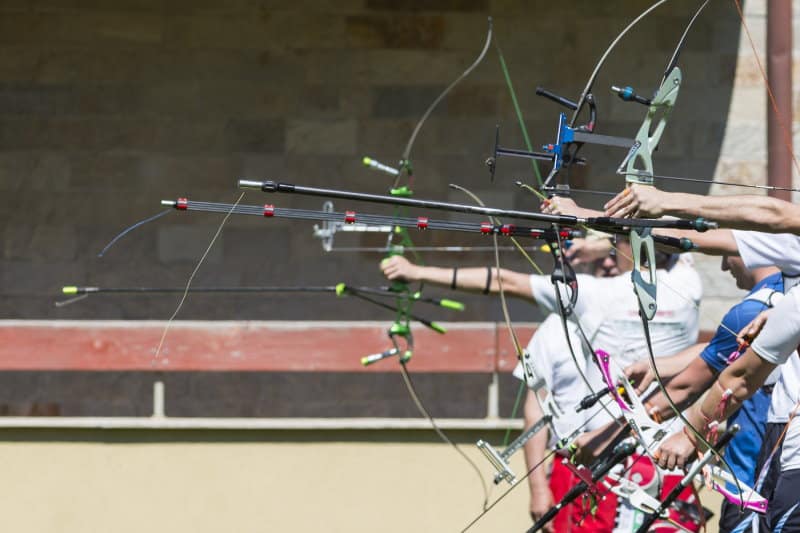There are always limits to what you can do with a bow. However, all beginners—even some enthusiasts—are always looking to test out the limits of their bows. When they get their hands on a bow, they start to wonder, can you leave a recurve bow strung?
You can leave a recurve bow strung for an almost unlimited amount of time, but you really shouldn’t. If you do that, you will damage the bow, wear the strings down, and possibly break the bow or injure yourself. Therefore, you should always avoid doing it.
If knowing that didn’t quite persuade you to avoid doing so, here are some more facts on why you shouldn’t leave a recurve bow strung. No matter how marvelous it is, even the bow has its limits.
The Limits of The Bow
Each bow comes with a limit, the first being in the draw weight of the bow. Basically, the draw weight is a weight that dictates the power of the bow. More precisely, it’s the type of power you can produce with the bow.
It’s also the minimal required strength for you to draw that bow. Recurve bows are usually bows with less draw power, as they are made mostly for practice, tournaments, and hunting small game. Therefore, you cannot expect them to hold much pressure on the strings.
The first thing you should know is that the drawing power of the bow is its true limit. If you use it beyond that limit and try to apply more pressure on it than it can handle, the bow is surely going to break.
Of course, there are recurve bows of lesser and higher quality; therefore, it’s to be expected that a higher-quality bow will withstand more tearing, use, and overall damage. However, it’s still possible to break it if you aren’t using it properly.
So, what most beginners should do is to get to know all aspects of their bow. No matter if you are using a longbow, recurve bow, or a compound bow, you have to learn its anatomy, strength, weaknesses, and qualities.
Only then you can ensure a longer use of your bow over time.
But if you’re here because your bowstring has broken recently, then do yourself a favor and get yourself a new one.
If you don’t know what string to use in your recurve, then keep the learning going by checking out this video:
Wearing The Bow Down
Wearing the bow down will happen, regardless of how much you take care of it. Likewise, that is exactly the point of why you should prevent wearing your bow down. Good archery equipment is not cheap.
So, if you are serious about archery, you should learn how to take care of your bow. Even if archery is merely a hobby for you, the maintenance of the bow is something you should learn, along with other fundamental skills.
Aside from not properly storing your bow, using the wrong arrows, lacking actual skills in handling the bow will be what wears it down the most. Therefore, avoiding dry fire and putting on more pressure than the bow can handle should be some of your top priorities.
The whole point of the distance between a master archer and a novice is in their ability to handle the bow. When you don’t know how to use it properly, you are essentially wrecking the bow by adding more weight to each shot than the bow can handle.
Another part of the recurve bow that you will want to watch out for is with the string. Without a string, you can’t fire an arrow, defeating the whole purpose of the bow. Firing each shot according to the best practice of the archery technique is what will make all the difference.
So, if you really wanted to keep a recurve bow strung, you should at least stay away from a full-wood bow, and low for a fiberglass one.
How Long Can a Recurve Bow Be Strung

Now, we come to the big question. The answer may shock you, but you can leave a recurve bow strung for an unlimited amount of time, depending on its material and build. However, even if you can do something like that, that doesn’t mean you necessarily should.
Keeping the strings tense at all times won’t do direct damage to the bow itself, as if to break it from tension. The way the tension will affect the bow is directly connected to how the bow was built.
For example, a full-wood bow will get damaged when doing this because wood is more prone to damage than other materials. Most recurve bows nowadays are made from fiberglass, which is a great and strong material made to last and endure different types of conditions.
So, a fiberglass bow can be strung for an unlimited amount of time, without causing any damage to the bow itself. However, that also comes in a certain condition.
You have to protect the bow from humidity, high temperature, rain, water in general, and other conditions that may come with everyday life. If these conditions start affecting the bow, it will wear it down nonetheless, and maybe even lead to dry fire.
Dry Fire

Another problem you are going to deal with when your bow is strung is dry fire. This can happen at any time you are pulling the bow without an arrow inserted in it. Dry fire is basically a backlash that happens when you pull the string, release it, and let it hit the body of the bow.
It will hit even stronger if the bow has been strung for a while, then released suddenly. So, you will want to make sure you know how to handle your bow properly. You will also want to be able to unstring it without causing dry fire.
Luckily or not, this could be a good situation for a young archer, as it will allow them to have a chance to ascertain their skills. However, note that one of the downsides is the potential for injury. The other reason why you shouldn’t test the recurve bow in this way is that you can get hurt by doing so.
Make sure you’re using recurve arrows and not compound arrows. For more on the difference between these two, check out this article.
Possible Injuries
There are a number of injuries that can happen if you don’t properly take care of your bow. First, you will want to avoid dry fire at all costs. Even with less draw power, the string will still hurt your palm and fingers, meaning there will still be some damage.
Now, imagine that you have a fully strung bow that you are possibly mishandling. When you fire, the string will probably end up seriously hurting your arm.
One of the two injuries you should consider is any that may occur to your fingers. You won’t slice them off or anything to that extent; however, you will still damage them severely, which won’t allow you to hold the bow for some time.
The other injury that could occur can be a palm or an arm laceration. When the string hits your arm, the pressure could be so strong that it ends up cutting your arm. Once that happens, there could also be some complications.
Therefore, you will want to keep proper care of your bow.
Taking Care of Your Bow
In the end, you will really want to take proper care of your bow. This means that you will maintain it and keep it from conditions that will wear it down. To do all that, you will really just have to be careful with it.
First, you will want to understand how to maintain your bow depending on the type of material the bow is made of. Here, the type of recurve bow would play a big part. If you have a bow that’s made completely of wood, maintaining it will be rather difficult.
The tougher the material, the less maintenance it will require. For example, fiberglass bows are much more resistant than those made of wood. It can also survive in various weather conditions much better.
For example, you will need to think about the potential humidity, temperature, air, and sunlight exposure that may reach your bow. If you merely let the bow be exposed and succumb to these conditions, the bow will wear down much faster. Stringing it out will also end up being potentially dangerous, since it may break halfway or snap while you are pulling it.
Don’t Keep It Strung Too Long
Now you know what you can do and what you can’t do with a bow. While you can keep it strung, possibly forever, it’s not necessarily something you should do. Therefore, instead of testing out the limits of the bow, make sure you are taking good care of it.
Bows are, after all, made for shooting, so make them last for that. There’s no point in having a bow that won’t help you achieve its one and only mission. That mission is to shoot, so keep shooting.

